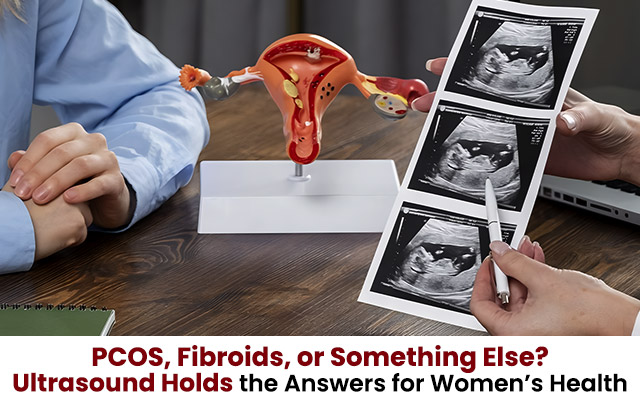Women often experience irregular periods, pelvic pain, or bloating. These common symptoms can point to a variety of reproductive health conditions.
PCOS (Polycystic Ovary Syndrome) and fibroids are two such conditions that cause confusion. But how do you know which one you’re dealing with? The answer lies in an ultrasound diagnosis. 🌸
Sugarline Healthcare, a USG centre in Kolkata, offers advanced ultrasound imaging. It helps women gain clarity about their health. Ultrasound is a non-invasive, safe, and effective diagnostic tool. It can detect a range of gynecological conditions. The ultrasound is the first step to diagnose conditions like PCOS and fibroids.
How Ultrasound Helps in Women’s Health
Ultrasound offers a comprehensive view of the ovaries and uterus. Using sound waves, it creates images of the organs, helping detect issues like:
- Polycystic ovaries, which show multiple small cysts on the ovaries
- Fibroids are tumours in the uterus that can vary in size and location
- Ovarian cysts, which are often confused with fibroids
Pelvic ultrasound, particularly transvaginal ultrasound, is effective for detecting these issues. It allows a closer look at the uterus and ovaries. This makes it the best choice for ultrasound diagnosis of PCOS and fibroids.
PCOS Ultrasound Diagnosis: The Key Indicators
PCOS ultrasound diagnosis focuses on detecting the characteristic signs of the condition.
Here’s how ultrasound plays a crucial role in identifying PCOS:
- Ovarian Volume and Follicle Count
PCOS is marked by multiple small cysts (follicles) on the ovaries. Ultrasound can measure the size of the ovaries and check for the number of follicles. It helps doctors diagnose the condition.
- Polycystic Ovary Morphology
A common ultrasound feature in PCOS is the presence of a “string of pearls” appearance. This refers to multiple small cysts along the outer edge of the ovaries.
- Hormonal Imbalance Effects
Ultrasound can also assess the effects of hormonal imbalances in the ovaries. It is an indicator of PCOS.
Doppler ultrasound can further assess the blood flow to the ovaries. It helps check for any irregularities caused by the hormonal imbalance. This gives a clearer picture of how the condition is affecting the ovaries.
Fibroids Ultrasound Detection: Understanding Uterine Fibroids
When it comes to fibroids, ultrasound detection determines the size, number, and location of fibroids. Here’s how ultrasound can help:
- Size and Location
Fibroids are benign tumours in the uterus. Ultrasound shows their size and position. It allows doctors to assess how much they might be affecting surrounding tissues.
- Types of Fibroids
Different types of fibroids (submucosal, intramural, or subserosal) appear on an ultrasound. Knowing this helps doctors choose the best treatment approach.
- Monitoring Growth
Regular ultrasound scans are necessary to track the growth of fibroids. It helps plan for pregnancy or undergoing non-surgical treatments.
Ultrasound imaging for fibroids also helps determine if surgery is required. If you’re suffering from excessive bleeding, an ultrasound can offer insights.
Differentiating PCOS and Fibroids: Why it Matters
The symptoms of PCOS and fibroids can overlap. Both can cause pelvic pain, heavy periods, and bloating. But their causes and treatment options are very different. Here’s why ultrasound is crucial for differentiation:
- Irregular Cycles vs. Heavy Bleeding
PCOS is often linked to irregular or missed periods due to hormonal imbalance. Fibroids, on the other hand, tend to cause heavy bleeding, which can lead to anaemia. - Ovarian Cysts vs. Fibroids
Ovarian cysts (common in PCOS) are fluid-filled sacs on the ovaries. On the other hand, fibroids are solid tumours within the uterus. Ultrasound helps to distinguish these two, preventing misdiagnosis.
Having an ultrasound ensures accurate differentiation between PCOS and fibroids. It ensures a personalised treatment plan.
People Also Ask
- Can ultrasound detect both PCOS and fibroids?
Yes, a pelvic ultrasound is effective for detecting both conditions simultaneously. It offers clear images of the ovaries and uterus.
- Is a transvaginal ultrasound better for PCOS diagnosis?
Yes, a transvaginal ultrasound provides more detailed images of the ovaries. It helps doctors identify the follicle count and any cysts related to PCOS.
- How often should I get an ultrasound for gynecological health?
The frequency depends on your symptoms, risk factors, and the doctor’s advice. Regular check-ups are essential for women with known conditions like PCOS or fibroids.
Take Control of Your Health Today
Understanding the root cause of your symptoms is empowering. Ultrasound provides answers and is the first step in your journey to better health.
Book Your Ultrasound at Sugarline Healthcare
Visit Sugarline Healthcare, a USG centre in Kolkata, for precise and safe imaging.

